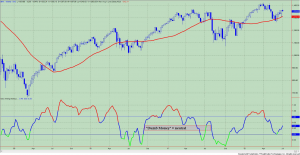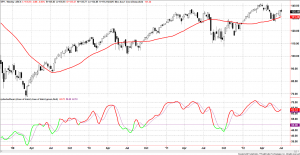by Guy Lerner, The Technical Take
Last week’s comments will certainly suffice to explain how sentiment is impacting the current price action, so here they are: “From a sentiment perspective, the data remains consistent with a market top rather than the next launching pad to a new bull market or even a sustainable bull run. For several weeks, I have been of the opinion that whatever bounce develops would not carry too far because sentiment really wasn’t too bearish at the bottom. Large rallies usually start with real extremes in investor sentiment and consensus among the sentiment data, which we did not see despite the SP500 dropping about 10% over 8 weeks from the April highs. Although the “dumb money” was bearish (i.e., bull signal), corporate insiders were neutral. Throw in the fact that investors have been primed to front run anything that sounds like quantitative easing or bail out, you can understand why investors weren’t too concern. Don’t worry some central banker has your back.”
What I find fascinating is that investors know what is exactly driving this market. It is bailouts, quantitative easing, asset purchases or whatever you want to call it. These plans can be real or just come from the mouths (i.e., jawboning) of central bankers. I was listening to CNBC earlier in the week, and the disappointment of the hosts over the market’s response to the European Central Bank’s rate cut was palpable. With the pre-market futures down about 0.5%, they immediately understood that some entity (i.e., Federal Reserve) would need to step in and do more. Mind you this is pre-market action, and the SP500 is still only a couple of percent below the recent cyclical highs! No reason to hope for a good jobs report or better earnings. Maybe that is asking for too much. Or maybe investors understand that positive data points takes more QE off the table.
The promises to fix the economies (i.e., equity markets) of the world with more debt are coming almost daily now. The market’s response to each of these “fixes” seems to be getting less and less. In addition, whether QE is the right policy still remains in doubt. After all, it hasn’t turned the US economy around yet and some would argue, asset purchases and debt creation have put the US economy on a weaker foundation. It would seem that investors are in a pickle. More of the same is not working, and it just may require lower equity prices for investors to get what they really wish for.
The “Dumb Money” indicator (see figure 1) looks for extremes in the data from 4 different groups of investors who historically have been wrong on the market: 1) Investors Intelligence; 2) MarketVane; 3) American Association of Individual Investors; and 4) the put call ratio. This indicator is neutral.
Figure 1. “Dumb Money”/ weekly

Figure 2 is a weekly chart of the SP500 with the InsiderScore “entire market” value in the lower panel. From the InsiderScore weekly report: “Insider trading volume began a seasonal decline last week. Companies generally close trading windows for insiders 10-14 days prior to quarter’s end and reopen them following their subsequent earnings announcement. Volume will continue to dissipate over the next few weeks and getting a macro read will be difficult because of the limited number of insiders who are free to trade.”
Figure 2. InsiderScore “Entire Market” value/ weekly

Figure 3 is a weekly chart of the SP500. The indicator in the lower panel measures all the assets in the Rydex bullish oriented equity funds divided by the sum of assets in the bullish oriented equity funds plus the assets in the bearish oriented equity funds. When the indicator is green, the value is low and there is fear in the market; this is where market bottoms are forged. When the indicator is red, there is complacency in the market. There are too many bulls and this is when market advances stall. Currently, the value of the indicator is 63.72%. Values less than 50% are associated with market bottoms. Values greater than 58% are associated with market tops. It should be noted that the market topped out in 2011 with this indicator between 70% and 71%.
Figure 3. Rydex Total Bull v. Total Bear/ weekly














